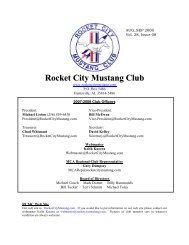2006 Ford Racing Performance Parts Catalog - Rocket City Mustang ...
2006 Ford Racing Performance Parts Catalog - Rocket City Mustang ...
2006 Ford Racing Performance Parts Catalog - Rocket City Mustang ...
Create successful ePaper yourself
Turn your PDF publications into a flip-book with our unique Google optimized e-Paper software.
CHECKING CAMSHAFT TIMING<br />
In order to check cam timing, you will need<br />
some specialty tools. You will need a degree<br />
wheel, dial indicator with magnetic base, and a<br />
heavy wire for a timing pointer. Choose a large<br />
diameter wheel as they are easier to read and<br />
more durable. Some manufacturers sell kits<br />
with a rigid, adjustable pointer that mounts<br />
easily to the front the engine. The other option<br />
is a heavy wire that is mounted to the block<br />
and bent into position.<br />
Start with placing the dial indicator and stand<br />
on the right side block deck to measure travel<br />
of the CENTER of piston number 1 (passenger<br />
side, front). Bring number 1 to TDC (Top Dead<br />
Center) by observing when the dial indicator<br />
stops moving. Bolt the degree wheel to the<br />
front of the crankshaft, and attach the pointer<br />
to the front of the block, so that the pointer is<br />
positioned at the zero degree reading on the<br />
wheel. To find exact TDC, first set the dial<br />
indicator to zero at the point of highest piston<br />
travel. Next, turn the crankshaft counter<br />
clockwise about 90 degrees. Then, slowly<br />
rotate the crankshaft clockwise (the normal<br />
direction of engine rotation) until the indicator<br />
is .030" below the TDC (zero) setting. Note the<br />
reading of the degree wheel at this point. Then,<br />
continue turning the crankshaft clockwise past<br />
the TDC about 90 degrees. Slowly rotate the<br />
crankshaft backwards counter clockwise until<br />
the same .030" below TDC is seen on the dial<br />
indicator. Again, note the degree wheel reading.<br />
Next, rotate the degree wheel so the pointer<br />
falls at the AVERAGE of the two observed<br />
readings. Lastly, relocate the pointer exactly<br />
over the zero reading of the degree wheel,<br />
and you will have perfectly dialed in TDC.<br />
Redo the procedure to satisfy yourself that<br />
the setting is correct, and then proceed to<br />
measure cam timing.<br />
Install the number 1 cylinder intake lifter in<br />
the proper lifter bore. Position the dial indicator<br />
so the tip is on the edge of the lifter or in the<br />
center of the lifter. Extensions for the dial<br />
indicator may be necessary. Carefully line up<br />
the dial indicator so the travel of the indicator<br />
is linear to the lifter. Rotate the engine and<br />
observe the action of the lifter. Make sure the<br />
fully open and fully closed positions of the lifter<br />
are within the travel range of the dial indicator.<br />
Rotate the crankshaft until the lifter is at the<br />
highest point of its travel, and set the dial<br />
indicator to zero. Continue rotating the engine<br />
clockwise until the lifter starts to travel up<br />
again. Slowly continue until the lifter is<br />
.030" below the point of maximum travel,<br />
and note the reading of the degree wheel.<br />
Start rotating the crank again until the lifter is<br />
.030" below the maximum travel on the closing<br />
side of the cam lobe. Note the degree wheel<br />
reading. The AVERAGE of the two readings<br />
taken is the location of maximum intake lift<br />
ATDC (After Top Dead Center).<br />
Compare this to the installation recommendation<br />
of the cam manufacturer, as it should be<br />
relatively close. The timing should be within<br />
one degree of the recommended setting. If<br />
there is a need to adjust the timing, FRPP has<br />
multi-index timing chain sets which have nine<br />
keyways to adjust cam timing.<br />
NOTE: Many cam manufacturers provide<br />
.050" lift cam timing information. To check<br />
this, reset the dial indicator to zero with the<br />
lifter at zero lift. Then rotate the crank in the<br />
clockwise direction until .050" lift is shown on<br />
the indicator. Note the intake open degrees.<br />
Then proceed clockwise until the intake closing<br />
at .050" lift is reached. Compare the readings<br />
to the cam card. Together with the maximum<br />
lift information, this data will tell you where the<br />
cam is degreed. Once corrections are made,<br />
measure the cam timing once more to verify<br />
the fix was correct.<br />
ENGINE<br />
COMPONENTS<br />
*Not legal for sale or use on pollution-controlled motor vehicles.<br />
**Direct replacement part.<br />
www.fordracingparts.com 79




